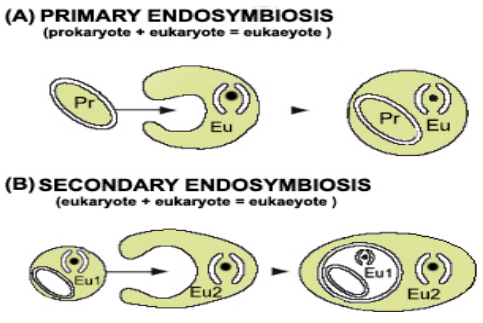
What is the difference between primary and secondary endosymbiosis?
Answer
436.2k+ views
Hint: There are many organisms existing in the environment that live in association with one another. They either help each other to satisfy nutritional needs or protect each other from predators.
Complete answer:
Endosymbiosis is a kind of symbiotic relationship in which two organisms live in association with each other such that one works as a host body for another. In simple words, one individual is found to be living inside the body of another one.
This endosymbiosis process is primarily of two types, that is, Primary endosymbiosis and secondary endosymbiosis.
Following is the difference between primary endosymbiosis and secondary endosymbiosis.

Note:
The symbiotic relationship is often regarded as the main reason behind the development of a double membrane in the cells and also in the cell organelles. Several organelles of the cells such as chloroplasts and mitochondria were once prokaryotic cells and underwent symbiosis to be transformed into their current form.
Complete answer:
Endosymbiosis is a kind of symbiotic relationship in which two organisms live in association with each other such that one works as a host body for another. In simple words, one individual is found to be living inside the body of another one.
This endosymbiosis process is primarily of two types, that is, Primary endosymbiosis and secondary endosymbiosis.
Following is the difference between primary endosymbiosis and secondary endosymbiosis.
| Parameters | Primary endosymbiosis | Secondary endosymbiosis |
| Definition | It is a process in which a eukaryotic cell engulfs a prokaryotic cell which can undergo photosynthesis. | It is a process in which a eukaryotic cell engulfs another eukaryotic cell which has already engulfed a prokaryotic cell in its past. |
| Sequence of Occurrence | The Primary endosymbiosis is the first in order to take place, i.e. it occurs before secondary endosymbiosis in all cases. | The Secondary endosymbiosis is the second in order to take place, i.e. it occurs after primary endosymbiosis in all the cases. |
| Examples | Cyanobacteria exhibit primary endosymbiosis. | Hatena exhibits primary endosymbiosis. |

Note:
The symbiotic relationship is often regarded as the main reason behind the development of a double membrane in the cells and also in the cell organelles. Several organelles of the cells such as chloroplasts and mitochondria were once prokaryotic cells and underwent symbiosis to be transformed into their current form.
Latest Vedantu courses for you
Grade 11 Science PCM | CBSE | SCHOOL | English
CBSE (2025-26)
School Full course for CBSE students
₹41,848 per year
Recently Updated Pages
Master Class 4 Maths: Engaging Questions & Answers for Success

Master Class 4 English: Engaging Questions & Answers for Success

Master Class 4 Science: Engaging Questions & Answers for Success

Class 4 Question and Answer - Your Ultimate Solutions Guide

Master Class 11 Economics: Engaging Questions & Answers for Success

Master Class 11 Business Studies: Engaging Questions & Answers for Success

Trending doubts
What is the difference between resemblance and sem class 12 social science CBSE

What is the Full Form of PVC, PET, HDPE, LDPE, PP and PS ?

Draw ray diagrams each showing i myopic eye and ii class 12 physics CBSE

Why do the transition elements have higher enthalpies class 12 chemistry CBSE

What are the advantages of parallel combination over class 12 physics CBSE

What are the causes of overloading class 12 physics CBSE




